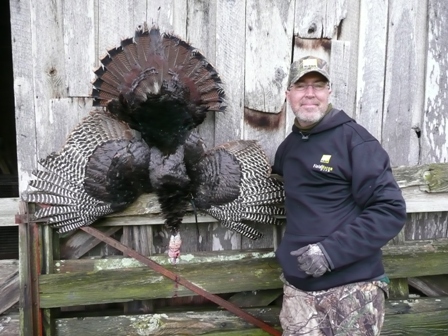Patience
Filed under: Hunting Blog, Turkey Hunting
Wild turkeys have had a low rate of nesting success during the past few years in portions of the Midwest. This is due to lots of rain during the nesting season and increased numbers of predators. There are still enough turkeys to hunt, but hunter success rates are decreasing.
This is not only because there are fewer gobblers compared to past years. A huge factor behind the declining hunter success rates is that there aren’t as many two year old gobblers present. Two year old toms tend to gobbler more than any other age class of gobblers. In addition, they tend to respond to calling by approaching rather than wait for the “hen” to come to them.
 By contrast, three year old and older gobblers tend to gobble less and wait for hens to come to them. This is probably a predator defense tactic and given the increasing number of predators, this tactic may be used even more than during the past. It’s a simple matter of selection. Toms that gobble a lot and respond by approaching calling are harvested more frequently by predators and hunters than toms that wait for the hen to approach them.
By contrast, three year old and older gobblers tend to gobble less and wait for hens to come to them. This is probably a predator defense tactic and given the increasing number of predators, this tactic may be used even more than during the past. It’s a simple matter of selection. Toms that gobble a lot and respond by approaching calling are harvested more frequently by predators and hunters than toms that wait for the hen to approach them.
Because of this, it usually takes more patience and skill to harvest a three year old or older gobbler. I’ve been blessed to have had much success at harvesting three year old and older toms. My rate of success with these mature birds has increased as I’ve gotten older and I am less likely to move when a gobbler doesn’t approach my calling rapidly or stops gobbling.
I’m much more willing to call to a tom, get a response, then remain in place even if the tom doesn’t gobbler for an hour or more. Mature toms will certainly respond to and come to a call. However, they rarely run to a call while gobbling the entire way.
By getting a tom’s attention and remaining in an area where toms have been known to strut or frequent, mature gobblers will frequently approach without gobbling. The more patience I gain as I mature, the better a turkey hunter I’ve become. I’m still a huge fan of the cut and run turkey hunting technique. I simply don’t “run” as much as I did when I was younger. Less “running” has allowed me and my guests to put more turkey breast in the freezer.
A principle I was taught in college is that change is the only constant. The demographics of many turkey populations have changed and therefore it has been advantageous for me to change my hunting techniques. By combining biology and woodsmanship, I have plenty to eat besides tag soup!
Growing Deer together,
Grant



